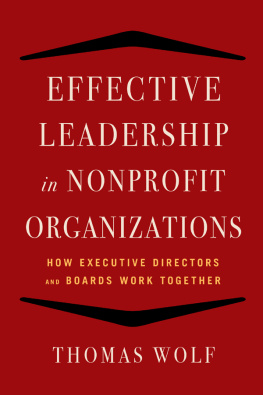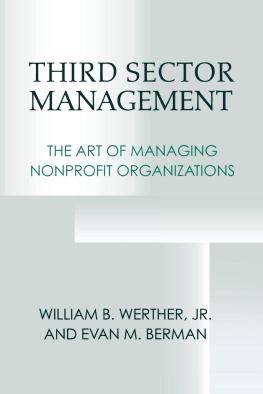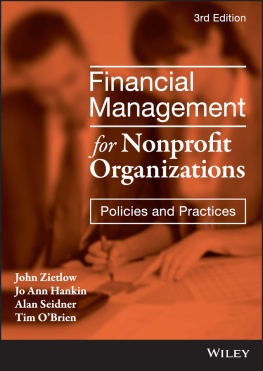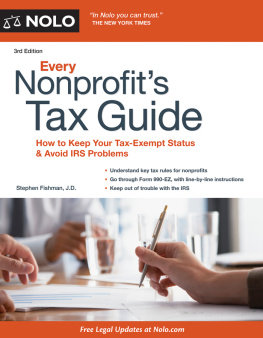STRATEGIC LEADERSHIP AND MANAGEMENT IN NONPROFIT ORGANIZATIONS

Oxford University Press is a department of the University of Oxford. It furthers the Universitys objective of excellence in research, scholarship, and education by publishing worldwide. Oxford is a registered trade mark of Oxford University Press in the UK and certain other countries.
Published in the United States of America by Oxford University Press
198 Madison Avenue, New York, NY 10016, United States of America.
Oxford University Press 2020
First Edition published in 2011
Second Edition published in 2020
All rights reserved. No part of this publication may be reproduced, stored in a retrieval system, or transmitted, in any form or by any means, without the prior permission in writing of Oxford University Press, or as expressly permitted by law, by license, or under terms agreed with the appropriate reproduction rights organization. Inquiries concerning reproduction outside the scope of the above should be sent to the Rights Department, Oxford University Press, at the address above.
You must not circulate this work in any other form and you must impose this same condition on any acquirer.
Library of Congress Cataloging-in-Publication Data
Names: Golensky, Martha, author. | Hager, Mark A., author.
Title: Strategic leadership and management in nonprofit organizations: theory and practice / Martha Golensky, Emeritus, Grand Valley State University, Mark A. Hager, Arizona State University.
Description: Second Edition. | New York : Oxford University Press, 2019. | Revised edition of Strategic leadership and management in nonprofit organizations, c2011.
Identifiers: LCCN 2019032301 (print) | LCCN 2019032302 (ebook) |ISBN 9780190097844 (paperback) | ISBN 9780190097868 (epub) | ISBN 9780190097851 (updf)
Subjects: LCSH: Nonprofit organizationsManagement. | Nonprofit organizations. | Strategic planning. Classification: LCC HD62.6 .G64 2019 (print) | LCC HD62.6 (ebook) | DDC 658.4/092dc23
LC record available at https://lccn.loc.gov/2019032301
LC ebook record available at https://lccn.loc.gov/2019032302
Contents
Welcome to the second edition of Strategic Leadership and Management in Nonprofit Organizations! The first edition was written wholly by Martha Golensky, a culmination of knowledge and experience she gained through fifteen years as a nonprofit executive and twelve years as a full-time university professor, teaching nonprofit management courses, conducting research on leadership and decision-making, and providing consultation to local organizations on management issues. In the second edition, Golensky is joined by Mark Hager, who directs the masters degree in nonprofit leadership and management at Arizona State University. Fans of the first edition will be glad to know that this revised edition maintains the bones and content of the original edition.
So whats new? Many of the classic references that have had so much influence on the field are still here, but we have updated each chapter with new thinking and research from the past decade. When statistics are used to provide context for a particular topic, we have updated those. In some chapters, Hager has added more flavor that reflects his expertisefor example, you will find expansions in the chapter on volunteer administration, a topic on which Hager has written extensively. Perhaps the biggest change is in our references to technology, which has influenced the nonprofit workplace in every way over the past decade. When the first edition of this book was written, social media and smartphones had not been invented yet. Now, they are fundamental parts of our lives, and nonprofits make use of them every day to interact with their stakeholders. So, the second edition of Strategic Leadership and Management in Nonprofit Organizations melds classic research with new thinking on how best to run nonprofits.
Although the book incorporates the work of many scholars in the field of nonprofit and philanthropic studies, it is fundamentally practical in its orientation. It takes as its departure point the smorgasbord of challenges facing real-life decision makers in todays worldchallenges around service delivery, staff performance, financial stability, interaction with a board of directors, strategic planning, program effectiveness, volunteer engagement, and uses of technology.
The principal audience for the book is students of the nonprofit sector. This includes professionals who are about to or have recently entered the workplace as interns, employees, or volunteers, in direct practice or a supervisory role. Our goal is to help you understand how nonprofit organizations function and to increase your appreciation of the conflicting demands on the board and top management team. More experienced staff, especially those engaged in the daunting task of effecting organizational change, may also find the book a useful resource. Workers at all levels must have both technical competency and the ability to navigate skillfully through the intricacies of the work culture.
A distinctive feature of the book is the use of an extended case study to illustrate different leadership and management issues. The case, which Golensky wrote to use in the classroom, is based on the experience of a real human service organization. Unlike most case studies, this one tells the organizational story from two viewpoints: the executive director and the board president. These two important leaders disagree on the best strategy for the agencys future. Thus, the case mimics real life, where critical decisions are seldom simple. By addressing a range of significant organizational issues as seen through the eyes of the key decision makers, the case featured in this book should stimulate both personal reflection and lively discussion about basic concepts, processes, and their consequences.
In addition to the case study, the book includes many examples of the issues nonprofit leaders and senior managers face. Some are relatively new concerns, such as how to incorporate individuals who wish to volunteer only now and then, or episodic volunteers. Some have a long tradition, like promoting the effectiveness of the board of directors. Although many of the examples in the book are drawn from the human services, they depict situations common to a variety of nonprofit organizations.
Organization
The book is organized into four sections. The introduction to each section summarizes the contents and lists key themes. Portions of the case study, addressing many of these same themes, appear in the introductions for . The last part of the case, containing the resolution of the conflict between the two main characters, appears only in the accompanying teachers manual, so readers can reach their own conclusions about the issues in the case. Each chapter ends with discussion questions and recommended reading.
provides the context for the rest of the book. Here the focus is on the characteristics of a nonprofit organization, with an explanation of the specific attributes of both charitable and member-serving nonprofits. We also consider the historical development of the nonprofit sector as a whole and of the human services subsector in particular. This section also features a review of the political and economic climate in which nonprofits must operate.
In , the concept of leadership is examined from several perspectives, starting with general theories of leadership and the particular structure of leadership in a nonprofit. Next, the multiple roles of the nonprofit professional leader are delineated, to recognize that the same person may serve as manager and administrator, motivated by different priorities when functioning in each capacity. Ethical issues are also considered. The last two chapters in this section are concerned with the theoretical and practical aspects of decision-making and the relationship between organizational culture and organizational change, a critical element of present-day leadership and management in nonprofits.











